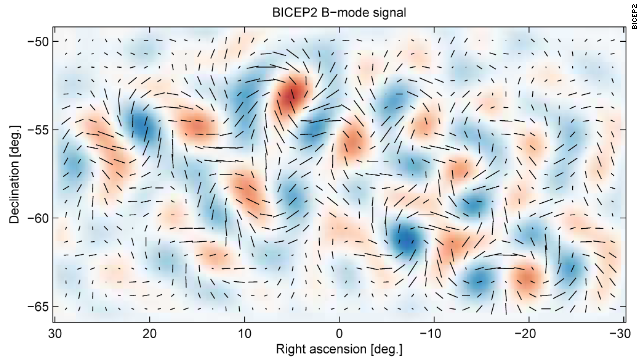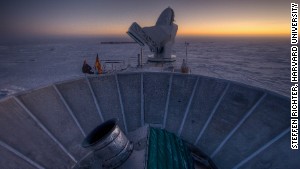
This plot represents the twisting pattern in the polarization of light left over from the Big Bang.
STORY HIGHLIGHTS
- Gravitational waves were predicted by Albert Einstein
- New results from BICEP2 are 'smoking gun for inflation'
- During inflation, the universe expanded faster than the speed of light
If the discovery holds up
to scrutiny, it's evidence of how the universe rapidly expanded less
than a trillionth of a second after the Big Bang.
"It teaches us something
crucial about how our universe began," said Sean Carroll, a physicist at
California Institute of Technology, who was not involved in the study.
"It's an amazing achievement that we humans, doing science
systematically for just a few hundred years, can extend our
understanding that far."
What's more, researchers
discovered evidence for the first time of what Albert Einstein predicted
in his general theory of relativity: Gravitational waves.
These are essentially
ripples in space-time, which have been thought of as the "first tremors
of the Big Bang," according to the Harvard-Smithsonian Center for
Astrophysics.
A telescope at the South Pole called BICEP2 -- Background Imaging of Cosmic Extragalactic Polarization 2
-- was critical to the discovery. The telescope allowed scientists to
analyze the polarization of light left over from the early universe,
leading to Monday's landmark announcement.

The BICEP2 telescope looks at polarization of light from 380,000 years after the Big Bang.
How inflation works
Scientists use the word
"inflation" to describe how the universe rapidly expanded after the Big
Bang in a ripping-apart of space. The BICEP2 results are the "smoking
gun for inflation," Marc Kamionkowski, professor of physics and
astronomy, said at a news conference. Kamionkowski also was not involved
in the project.
"Inflation is the theory
about the 'bang' of Big Bang," said Chao-Lin Kuo, an assistant professor
of physics at Stanford and SLAC National Accelerator Laboratory, and a
co-leader of the BICEP2 collaboration, in a Stanford video. "It explains why we have all this stuff in the universe."
Imagine that you are
making a raisin bun, said Stanford physicist Kent Irwin, who worked on
sensors and readout systems used in the experiment. As the dough bakes
and expands, the distance from any given raisin to another increases.
"Certainly everything in
the universe that we see now, at one time before inflation, was smaller
than an electron," Irwin said. "And then it expanded during inflation
at faster than the speed of light."
You may have learned in
physics class that light sets the universe's speed limit, but space-time
is an exception; it can stretch faster than the speed of light, Irwin
said.
Stanford University
professor Andrei Linde, who helped develop the current inflation theory,
said the new results are something he had hoped to see for 30 years.
"If this is true, this
is a moment of understanding of nature of such a magnitude that it just
overwhelms and let's just hope that it's not a trick," Linde said in a
university video interview.
Another cool tidbit:
Inflation can be used in theories that suggest the existence of multiple
universes, Irwin said, although these results do not directly address
such theories.
What are gravitational waves?
Scientists believe that
in the fabric of space-time, there are tiny ripples called quantum
fluctuations. If you could look at space-time on the smallest scale
possible, you would, in theory, see them, even today. Unfortunately, no
microscope is capable of seeing something that small.
Such fluctuations also
existed at the beginning of the universe. Inflation, said Irwin, blew
them up much larger. That is what we think of as gravitational waves.
"We have for the first
time a detection for the mythical gravity wave signal that people have
been searching for so hard, for so long," said Clem Pryke, associate
professor at the University of Minnesota, at a press conference Monday.
Other experiments such as LIGO -- Caltech's Laser Interferometer Gravitational Wave Observatory
-- are also looking for proof of gravitational waves, but in the
context of energetic cosmic phenomena such as coalescing black holes.
The gravitational waves
suggested by the BICEP2 results would have expanded across the entire
universe at that time, Irwin said. The length of one of these waves --
the distance between peaks and troughs -- would have been billions of
light years across.
Light from the early
universe, called cosmic microwave background radiation, reveals these
telltale signs of our universe's history. Last year, scientists from the
European Space Agency's Planck space telescope released a detailed map of temperature variations in this light, which came from from about 380,000 years after the Big Bang.
Instead of temperature,
BICEP2 scientists were looking specifically at the polarization of the
cosmic microwave background -- that is, the direction the electric field
is pointing across the sky.
Researchers were looking
for a specific type of polarization called "B-modes," which signify a
curling pattern in the polarized orientations of light from the ancient
universe, said Jamie Bock, co-leader of the BICEP2 collaboration and
professor of physics at California Institute of Technology.
In theory, this swirling polarization pattern could only be created from gravitational waves. And that is what BICEP2 found.
"It's a very clean signature of those gravity waves," Irwin said.
Is it for real?
Because of how
potentially important these results are, they must be viewed with
skepticism, said David Spergel, professor of astrophysics at Princeton
University. The measurement is a very difficult one to make and could
easily be contaminated. There are, as it stands, some "oddities" in the
results that could be concerning, he said.
"I am looking forward to seeing these results confirmed or refuted by other experiments in the next year or two," Spergel said.
The Planck space
telescope collaboration is expected to release results on polarization
of the cosmic microwave background as well, Irwin said. Other
experiments are working toward similar goals, which could support or go
against BICEP2.
Regardless, Monday's announcement is making big waves in the scientific community.
Aucun commentaire:
Enregistrer un commentaire
Remarque : Seul un membre de ce blog est autorisé à enregistrer un commentaire.